There is an incredible variety of potatoes from around the world – literally thousands of them. Different varieties of potatoes vary in texture. They can be starchy, waxy, or somewhere in-between. Some potatoes are great for mashing while others work best if baked or roasted.
At the grocery store there are usually signs above the potatoes that will tell you which ones are great for baking versus which ones are better for mashing. Some potatoes are described as “all-purpose” which means you can cook them any way you want.
What’s common to all potatoes is that they’re incredibly versatile and nutritious. They contain iron, Vitamin C, potassium and starch. Sweet potatoes – which are actually a very distant relative of regular potatoes – are loaded with Vitamin A, C and B6. In general, potatoes can be boiled, baked, steamed, microwaved, and used in salads, soups and stews.
Starchy, Waxy or All-Purpose?
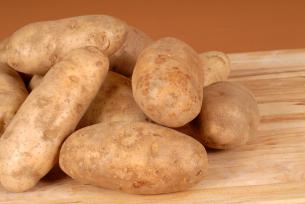
Russet or Idaho potatoes have a starchy texture that works well for baking.
Starchy Potatoes (aka baking potatoes) are good to use for baking, French fries and mashing. They tend to come apart when cooked, so they’re not great for dishes like Potato Hash.
Some examples: Russet (aka Idaho), Norchip, Goldrush, Norkotah, Long white, Jewel Yam, Japanese Sweet potato, Hannah Sweet Potato
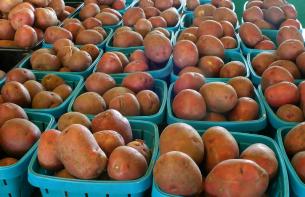
Small, round new potatoes taste great boiled.
Waxy Potatoes (aka boiling potatoes, round white, round red) keep their shape when cooked, so these are the best options for boiling, roasting or steaming. They’re also the best to use in dishes like potato salad or scalloped potatoes
Some examples: Warba, Rose Finn, Pontiac, Russian Banana, Red Thumb, French Fingerling, LaRette, Austrian Crescent, New potatoes
All-purpose
These potatoes fall somewhere between starchy and waxy, so they work in most recipes.
Some examples: Viking, All blue, Kennebec, Carlton, Yukon Gold, Norland Red, Purple Majesty.
Sweet Potatoes
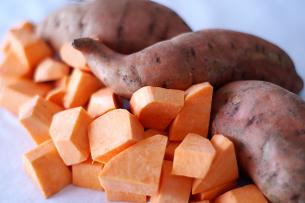
Sweet potatoes are often referred to as “yams” in the United States. Strictly speaking, they are not the same thing (not even related!). True yams are typically grown in parts of Africa, Asia, Latin America and the Caribbean – they are often brown or black, and can grow to be several feet long.
Follow the same guidelines for buying and storing sweet potatoes as you would other potatoes.
Sweet potatoes are often baked in their skins, or used to make sweet potato fries. There’s also the Thanksgiving classic, Sweet Potato Casserole (shown below), which is often topped with marshmallows!
startcooking.com’s Sweet Potato Casserole
Buying and Storing
- Look for potatoes that are unblemished and don’t have a green tinge. A greenish skin color signals that the potato has had too much exposure to light. These potatoes may actually taste bitter and cause digestive (and other) problems. If the potato is only partially green, you can remove the green part and use the rest.
- The worst place to store potatoes is in the fridge – this affects their taste and color. They should be kept in a cool, dark and dry place (not under the kitchen sink), and away from onions.
- If stored at room temperature, they’ll last about a week. If stored between 45 and 50F (7 to 10C), they’ll last several weeks.
- It’s better to store potatoes in a paper bag or cardboard box than in a plastic bag.
- Pre-washed potatoes will spoil more quickly than unwashed.
- If you’ve had some potatoes around for a while, you may notice that they start to sprout. According to the National Potato Council, this means that they’re being stored at too high a temperature. You can still use them – just cut the sprouts off.
How to Wash Potatoes
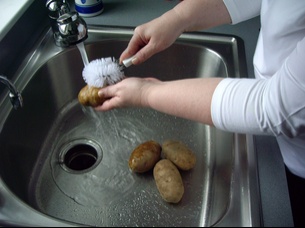 Wash them under running water, scrubbing the surface of the skin with a brush, or vigorously with your hands. Don’t use soap, though.
Wash them under running water, scrubbing the surface of the skin with a brush, or vigorously with your hands. Don’t use soap, though.
How to Peel Potatoes
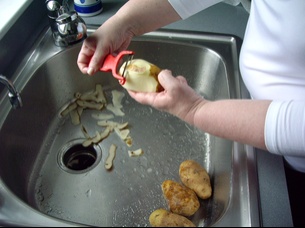 Depending on how you’re using potatoes, you may want to peel them. If you want to remove the skin before cooking, simply use a vegetable peeler and peel from one end of the potato to the other.
Depending on how you’re using potatoes, you may want to peel them. If you want to remove the skin before cooking, simply use a vegetable peeler and peel from one end of the potato to the other.
If you don’t like peeling, you can also remove the skin of a potato after boiling it. In this method, cut a shallow slit around the middle of the uncooked potato, and then boil it. After boiling, dunk the potato in ice water for a few seconds. When it’s cool enough to touch, it will be very easy to pull the skin off. The potato is then ready for mashing or using in a recipe.
When it Comes to Cooking Potatoes, Startcooking.com has Covered:
Here are More Basic Potato Recipes:
- Crepes of Wrath demonstrates (with photos!) a One-Skillet Potatoes, Sausages, and Peppers
- For The Love of Cooking has about 40 different potato recipes!
- Pioneer Woman shows us a twist on baked potatoes by demonstrating a great recipe created by Australian food writer Jill Dupleix, called Crash Hot Potatoes.
Enjoy!
If you are new to startcooking, or are a regular visitor here, please consider subscribing for free.



























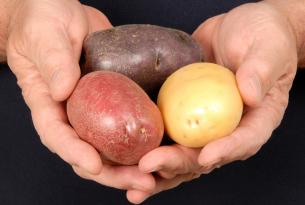














Diana said:
Hi there, thanks for all the great info on potatoes. I’m just curious about why they shouldn’t be stored next to onions. I just put up a hanging basket and have my potatoes in the bottom and the onions in the middle basket right above them.